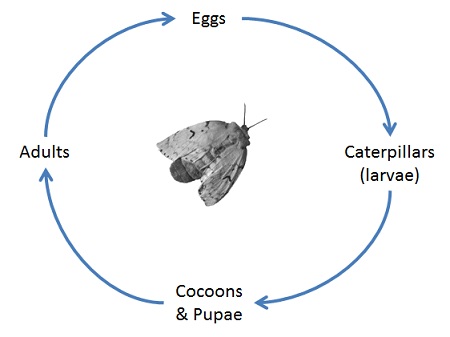
Gypsy moths go through four stages. Here is how the life of the gypsy moth unfolds through the seasons.
The larvae are most active during the months of May and June.
What is the life cycle of the gypsy moth caterpillar. Like other caterpillars gypsy moth larvae pass through several stages called instars as they feed and grow. For example after hatching the first instar larvae feed for approximately a week then molt shedding the outer layer of their exoskeleton and becoming second instars. The second instars feed for another five to eight days then molt and become third instars and so on.
Here is how the life of the gypsy moth unfolds through the seasons. In the fall females lay their eggs normally in crevices in trees. She covers the eggs with a layer of setae hair-like structures that help to keep the eggs warm and also deter any predators.
The eggs go into a phase called diapause. Essentially they wait out the winter to hatch as larvae caterpillars in the spring. Male caterpillars typically have five larval instars caterpillar.
The Gypsy Moths Life Cycle and Related Moths The Gypsy Moth. The gypsy moth undergoes a complete metamorphosis - changing from egg to larva caterpillar to pupa to adult. Gypsy moth eggs hatch generally between late April and mid-May.
The larval or caterpillar stage typically lasts about 7 weeks. The larvae are most active during the months of May and June. The individual larvae become.
Gypsy Moth Larva. Gypsy moth larva take the form of a caterpillar. They hatch in the spring from eggs laid the previous summer.
They crawl up trees and out on the limbs and start eating tree leaves. They start out small but soon grow larger as they eat tree leaves. When small they are lightweight and buoyant.
They suspend from trees on gossamer strands and get blown by the wind - sometimes. Whats the life cycle of the gypsy moth. Gypsy moths go through four stages.
Adult moths lay eggs toward the end of summer. The following spring usually around late April or. Unlike many other moths and butterflies the adult gypsy moth cannot feed.
The moth has about 2 weeks to find a mate before death. Completing their one year life cycle. Life Cycle of a Moth Moths go through a life cycle starting from an egg to being a larva also known as a caterpillar then pupa stage and finally the adult moth.
Each step is equally vital in the growth and development process. There are a lot of important factors involved in every phase of the development of a moth as discussed below. It is during the 7-week larval life stage in spring and early summer when gypsy moth caterpillars feed on the foliage of plant hosts.
If you live in the Northeast you likely associate gypsy moth with damage to oak trees. Certainly oaks are a plentiful and preferred host in this region suffering significant impacts when gypsy moth populations are high. However larvae feed on a wide range of.
Caterpillars the immature larval stage feed on the leaves of oaks aspens and many other trees in landscapes and in forested areas. During gypsy moth outbreaks caterpillar density can be so high that some trees may be completely stripped of leaves by mid-summer. Fortunately defoliation caused by gypsy moth caterpillars rarely kills trees.
The large hairy caterpillars however often annoy people. Gypsy moth caterpillars have a very distinctive pattern of raised bumps that no other caterpillar has. Look for two rows of blue bumps in the front and two rows of red bumps in the back.
If the caterpillar you have found has this pattern of raised spiny bumps then there is no question that you found a gypsy moth caterpillar. Once they become big and fat the caterpillar creates a shelter of silken threads on the side of the tree or your garden shed and turns into a cocoon. A short time later out comes the adult moth wings and all.
The moths do not feed they just look for mates and lay eggs. Male gypsy moths can fly the ladies cannot. So the girls hike it back up the same tree they grew up on while the lads flit about.
Rob Cole a forester with the DEC said were only in year one of that two- to three-year cycle. We started having an outbreak in the Finger Lakes and southern Adirondacks and most of that most damage is new for this year. Gypsy moth caterpillars go through five or six instars and feed from late April to mid June.
Most of the feeding occurs at night to protect caterpillars from extreme heat and predation by birds during the day. When fully mature caterpillars stop feeding and change into pupae. Adult moths emerge 7-10 days later.
There is one generation per year. These outbreaks generally cycle out through natural factors such as viruses and funguses that kill off excessive numbers of the gypsy moths. DEC has no plans in place for action against the infestation as the most effective time window to deal with the gypsy moth caterpillars has passed.
Currently DEC does not have any sort of eradication program Cole said. Typically this would be. Life History There are four distinct stages to the development of the Gypsy moth – egg larva pupa and adult moth.
The eggs are round black to brown in color and deposited in masses of 100 to 600 eggs in July and August. The tiny caterpillar overwinters inside the eggshell but does not hatch until the following April or May. When the eggs hatch the 14 inch 6-8 mm long caterpillars.